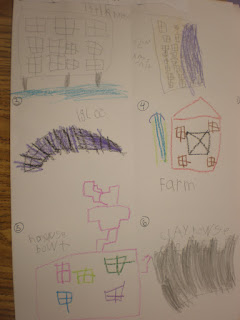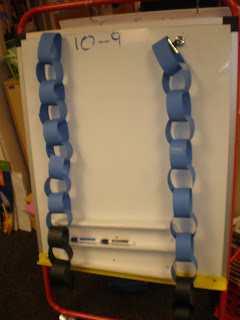Math seems to be the
time that I remember to get my camera out the most. I will try to take more
pictures of our literacy and writing time, I promise!
We talked about probability this week. We practiced
using the terms certain, possible,
and impossible. I read Cloudy
with a Chance of Meatballs to the students and we discussed things that
happened that were possible and impossible. The students then recorded in their
journals some possible and impossible things.
The next day we took
a deck of cards with just the 2’s through 10’s and the students took turns
pulling cards and discussing if the it was certain
that the next card would be higher, possible
that it would be higher, or impossible
for it to be higher. This is a higher order of thinking so I was very impressed
with how the students did!
They also took some
colored “beans” and shook and dumped them and recorded if they landed all the
same color or different colors. This is where we talked about how it was a
higher probability that they would be different, however it was possible to all
be red or white.
 |
| Recording that the beans landed as different colors |
We did some work
with addition and subtraction concepts this week. For majority students this is
an introductory skill; however some were ready to start recording number
sentences on whiteboards.
The students started
with the growing train game.
Starting with no cubes they rolled a dice (with just 1, 2, or 3 on it) and they
added that many to their train. This helped them understand that when we add we
get more.
The next day we
played disappearing train game. The
students started with 10 cubes and then rolled the dice and subtracted that
many from their rain. This showed that when we subtract we take away.
 |
| Great addition sentences! |
 |
| Adding 3 to the train |
 |
| Starting a subtraction problem |
I did manage to snag
2 pictures from our literacy time and writing.
We have been talking
about different types of houses so
this week students looked through books to find 6 types of homes. They then
drew those homes and labeled them. We have also discussed doing our best work so that anyone that looks at
our picture can tell what we drew.
 |
| Stick house, Apartment, Igloo, Farm, Houseboat, Clay house |
 |
| Apartment, igloo, barn, ?, clay house, houseboat |
In writing we have
been talking about Veteran’s Day. We
labeled a big picture of a soldier with characteristics of Veterans. The
students came up with: fought for our country, brave, care for people, keep us
safe, save people.
The next day the
students wrote thank you letters to the Veterans for all that they have done.
We finished up by making our own soldiers. They turned out wonderful so check
them out when you come to conferences next week!
 |
| Thank you for your fighting. Thank you fro the fighter planes. Thank you for (the) Air Force. Soldiers are nice. |











































